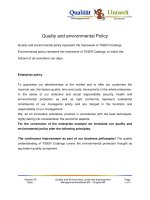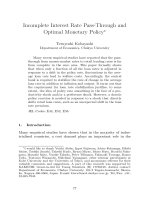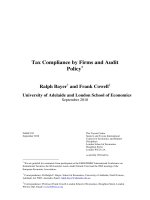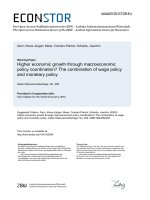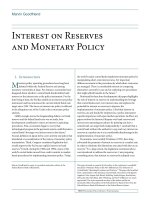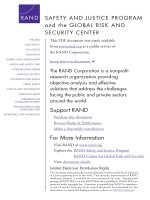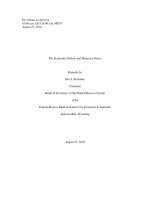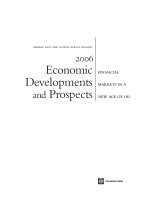The Economic Outlook and Monetary Policy docx
Bạn đang xem bản rút gọn của tài liệu. Xem và tải ngay bản đầy đủ của tài liệu tại đây (67.59 KB, 20 trang )
For release on delivery
10:00 a.m. EDT (8:00 a.m. MDT)
August 27, 2010
The Economic Outlook and Monetary Policy
Remarks by
Ben S. Bernanke
Chairman
Board of Governors of the Federal Reserve System
at the
Federal Reserve Bank of Kansas City Economic Symposium
Jackson Hole, Wyoming
August 27, 2010
The annual meeting at Jackson Hole always provides a valuable opportunity to
reflect on the economic and financial developments of the preceding year, and recently
we have had a great deal on which to reflect. A year ago, in my remarks to this
conference, I reviewed the response of the global policy community to the financial
crisis.
1
Notwithstanding some important steps forward, however, as we return once again
to Jackson Hole I think we would all agree that, for much of the world, the task of
economic recovery and repair remains far from complete. In many countries, including
the United States and most other advanced industrial nations, growth during the past year
has been too slow and joblessness remains too high. Financial conditions are generally
much improved, but bank credit remains tight; moreover, much of the work of
implementing financial reform lies ahead of us. Managing fiscal deficits and debt is a
daunting challenge for many countries, and imbalances in global trade and current
accounts remain a persistent problem.
On the whole, when the eruption of the Panic of 2008 threatened the very
foundations of the global economy, the world rose to the challenge, with a remarkable
degree of international cooperation, despite very difficult conditions and compressed time
frames. And when last we gathered here, there were strong indications that the sharp
contraction of the global economy of late 2008 and early 2009 had ended. Most
economies were growing again, and international trade was once again expanding.
This list of concerns makes clear that a return to strong and stable economic
growth will require appropriate and effective responses from economic policymakers
across a wide spectrum, as well as from leaders in the private sector. Central bankers
1
See Ben S. Bernanke (2009), “Reflections on a Year of Crisis,” speech delivered at “Financial Stability
and Macroeconomic Policy,” a symposium sponsored by the Federal Reserve Bank of Kansas City, held in
Jackson Hole, Wyo., August 20-22, www.federalreserve.gov/newsevents/speech/bernanke20090821a.htm.
- 2 -
alone cannot solve the world’s economic problems. That said, monetary policy continues
to play a prominent role in promoting the economic recovery and will be the focus of my
remarks today. I will begin with an update on the economic outlook in the United States
and then review the measures that the Federal Open Market Committee (FOMC) has
taken to support the economic recovery and maintain price stability. I will conclude by
discussing and evaluating some policy options that the FOMC has at its disposal, should
further action become necessary.
The Economic Outlook
As I noted at the outset, when we last gathered here, the deep economic
contraction had ended, and we were seeing broad stabilization in global economic
activity and the beginnings of a recovery. Concerted government efforts to restore
confidence in the financial system, including the aggressive provision of liquidity by
central banks, were essential in achieving that outcome. Monetary policies in many
countries had been eased aggressively. Fiscal policy including stimulus packages,
expansions of the social safety net, and the countercyclical spending and tax policies
known collectively as automatic stabilizers also helped to arrest the global decline.
Once demand began to stabilize, firms gained sufficient confidence to increase
production and slow the rapid liquidation of inventories that they had begun during the
contraction. Expansionary fiscal policies and a powerful inventory cycle, helped by a
recovery in international trade and improved financial conditions, fueled a significant
pickup in growth.
At best, though, fiscal impetus and the inventory cycle can drive recovery only
temporarily. For a sustained expansion to take hold, growth in private final demand
- 3 -
notably, consumer spending and business fixed investment must ultimately take the lead.
On the whole, in the United States, that critical handoff appears to be under way.
However, although private final demand, output, and employment have indeed
been growing for more than a year, the pace of that growth recently appears somewhat
less vigorous than we expected. Notably, since stabilizing in mid-2009, real household
spending in the United States has grown in the range of 1 to 2 percent at annual rates, a
relatively modest pace. Households’ caution is understandable. Importantly, the
painfully slow recovery in the labor market has restrained growth in labor income, raised
uncertainty about job security and prospects, and damped confidence. Also, although
consumer credit shows some signs of thawing, responses to our Senior Loan Officer
Opinion Survey on Bank Lending Practices suggest that lending standards to households
generally remain tight.
2
The prospects for household spending depend to a significant extent on how the
jobs situation evolves. But the pace of spending will also depend on the progress that
households make in repairing their financial positions. Among the most notable results to
emerge from the recent revision of the U.S. national income data is that, in recent
quarters, household saving has been higher than we thought averaging near 6 percent of
disposable income rather than 4 percent, as the earlier data showed.
3
2
The most recent survey is available on the Board’s website at
www.federalreserve.gov/boarddocs/SnLoanSurvey.
On the one hand,
this finding suggests that households, collectively, are even more cautious about the
economic outlook and their own prospects than we previously believed. But on the other
hand, the upward revision to the saving rate also implies greater progress in the repair of
3
Data are from the national and income product accounts produced by the Bureau of Economic Analysis,
U.S. Department of Commerce.
- 4 -
household balance sheets. Stronger balance sheets should in turn allow households to
increase their spending more rapidly as credit conditions ease and the overall economy
improves.
Household finances and attitudes also bear heavily on the housing market, which
has generally remained depressed. In particular, home sales dropped sharply following
the recent expiration of the homebuyers’ tax credit. Going forward, improved
affordability the result of lower house prices and record-low mortgage rates should
boost the demand for housing. However, the overhang of foreclosed-upon and vacant
housing and the difficulties of many households in obtaining mortgage financing are
likely to continue to weigh on the pace of residential investment for some time yet.
In the business sector, real investment in equipment and software rose at an
annual rate of more than 20 percent over the first half of the year. Some of these gains no
doubt reflected spending that had been deferred during the crisis, including investments
to replace or update existing equipment. Consequently, investment in equipment and
software will almost certainly increase more slowly over the remainder of this year,
though it should continue to advance at a solid pace. In contrast, outside of a few areas
such as drilling and mining, business investment in structures has continued to contract,
although the rate of contraction appears to be slowing.
Although most firms faced problems obtaining credit during the depths of the
crisis, over the past year or so a divide has opened between large firms that are able to tap
public securities markets and small firms that largely depend on banks. Generally
speaking, large firms in good financial condition can obtain credit easily and on favorable
terms; moreover, many large firms are holding exceptionally large amounts of cash on
- 5 -
their balance sheets. For these firms, willingness to expand and, in particular, to add
permanent employees depends primarily on expected increases in demand for their
products, not on financing costs. Bank-dependent smaller firms, by contrast, have faced
significantly greater problems obtaining credit, according to surveys and anecdotes. The
Federal Reserve, together with other regulators, has been engaged in significant efforts to
improve the credit environment for small businesses. For example, through the provision
of specific guidance and extensive examiner training, we are working to help banks strike
a good balance between appropriate prudence and reasonable willingness to make loans
to creditworthy borrowers. We have also engaged in extensive outreach efforts to banks
and small businesses. There is some hopeful news on this front: For the most part, bank
lending terms and conditions appear to be stabilizing and are even beginning to ease in
some cases, and banks reportedly have become more proactive in seeking out
creditworthy borrowers.
Incoming data on the labor market have remained disappointing. Private-sector
employment has grown only sluggishly, the small decline in the unemployment rate is
attributable more to reduced labor force participation than to job creation, and initial
claims for unemployment insurance remain high. Firms are reluctant to add permanent
employees, citing slow growth of sales and elevated economic and regulatory
uncertainty. In lieu of adding permanent workers, some firms have increased labor input
by increasing workweeks, offering full-time work to part-time workers, and making
extensive use of temporary workers.
Besides consumption spending and business fixed investment, net exports are a
third source of demand for domestic production. The substantial recovery in
- 6 -
international trade is a very positive development for the global economy; for the United
States, improving export markets are an important reason that manufacturing has been a
leading sector in the recovery. Like others, we were surprised by the sharp deterioration
in the U.S. trade balance in the second quarter. However, that deterioration seems to
have reflected a number of temporary and special factors. Generally, the arithmetic
contribution of net exports to growth in the gross domestic product tends to be much
closer to zero, and that is likely to be the case in coming quarters.
Overall, the incoming data suggest that the recovery of output and employment in
the United States has slowed in recent months, to a pace somewhat weaker than most
FOMC participants projected earlier this year. Much of the unexpected slowing is
attributable to the household sector, where consumer spending and the demand for
housing have both grown less quickly than was anticipated. Consumer spending may
continue to grow relatively slowly in the near term as households focus on repairing their
balance sheets. I expect the economy to continue to expand in the second half of this
year, albeit at a relatively modest pace.
Despite the weaker data seen recently, the preconditions for a pickup in growth in
2011 appear to remain in place. Monetary policy remains very accommodative, and
financial conditions have become more supportive of growth, in part because a concerted
effort by policymakers in Europe has reduced fears related to sovereign debts and the
banking system there. Banks are improving their balance sheets and appear more willing
to lend. Consumers are reducing their debt and building savings, returning household
wealth-to-income ratios near to longer-term historical norms. Stronger household
- 7 -
finances, rising incomes, and some easing of credit conditions will provide the basis for
more-rapid growth in household spending next year.
Businesses’ investment in equipment and software should continue to grow at a
healthy pace in the coming year, driven by rising demand for products and services, the
continuing need to replace or update existing equipment, strong corporate balance sheets,
and the low cost of financing, at least for those firms with access to public capital
markets. Rising sales and increased business confidence should also lead firms to expand
payrolls. However, investment in structures will likely remain weak. On the fiscal front,
state and local governments continue to be under pressure; but with tax receipts showing
signs of recovery, their spending should decline less rapidly than it has in the past few
years. Federal fiscal stimulus seems set to continue to fade but likely not so quickly as to
derail growth in coming quarters.
Although output growth should be stronger next year, resource slack and
unemployment seem likely to decline only slowly. The prospect of high unemployment
for a long period of time remains a central concern of policy. Not only does high
unemployment, particularly long-term unemployment, impose heavy costs on the
unemployed and their families and on society, but it also poses risks to the sustainability
of the recovery itself through its effects on households’ incomes and confidence.
Maintaining price stability is also a central concern of policy. Recently, inflation
has declined to a level that is slightly below that which FOMC participants view as most
conducive to a healthy economy in the long run. With inflation expectations reasonably
stable and the economy growing, inflation should remain near current readings for some
time before rising slowly toward levels more consistent with the Committee’s objectives.
- 8 -
At this juncture, the risk of either an undesirable rise in inflation or of significant further
disinflation seems low. Of course, the Federal Reserve will monitor price developments
closely.
In the remainder of my remarks I will discuss the policies the Federal Reserve is
currently using to support economic recovery and price stability. I will also discuss some
additional policy options that we could consider, especially if the economic outlook were
to deteriorate further.
Federal Reserve Policy
In 2008 and 2009, the Federal Reserve, along with policymakers around the
world, took extraordinary actions to arrest the financial crisis and help restore normal
functioning in key financial markets, a precondition for economic stabilization. To
provide further support for the economic recovery while maintaining price stability, the
Fed has also taken extraordinary measures to ease monetary and financial conditions.
Notably, since December 2008, the FOMC has held its target for the federal funds
rate in a range of 0 to 25 basis points. Moreover, since March 2009, the Committee has
consistently stated its expectation that economic conditions are likely to warrant
exceptionally low policy rates for an extended period. Partially in response to FOMC
communications, futures markets quotes suggest that investors are not anticipating
significant policy tightening by the Federal Reserve for quite some time. Market
expectations for continued accommodative policy have in turn helped reduce interest
rates on a range of short- and medium-term financial instruments to quite low levels,
indeed not far above the zero lower bound on nominal interest rates in many cases.
- 9 -
The FOMC has also acted to improve market functioning and to push longer-term
interest rates lower through its large-scale purchases of agency debt, agency mortgage-
backed securities (MBS), and longer-term Treasury securities, of which the Federal
Reserve currently holds more than $2 trillion. The channels through which the Fed’s
purchases affect longer-term interest rates and financial conditions more generally have
been subject to debate. I see the evidence as most favorable to the view that such
purchases work primarily through the so-called portfolio balance channel, which holds
that once short-term interest rates have reached zero, the Federal Reserve’s purchases of
longer-term securities affect financial conditions by changing the quantity and mix of
financial assets held by the public. Specifically, the Fed’s strategy relies on the
presumption that different financial assets are not perfect substitutes in investors’
portfolios, so that changes in the net supply of an asset available to investors affect its
yield and those of broadly similar assets. Thus, our purchases of Treasury, agency debt,
and agency MBS likely both reduced the yields on those securities and also pushed
investors into holding other assets with similar characteristics, such as credit risk and
duration. For example, some investors who sold MBS to the Fed may have replaced
them in their portfolios with longer-term, high-quality corporate bonds, depressing the
yields on those assets as well.
The logic of the portfolio balance channel implies that the degree of
accommodation delivered by the Federal Reserve’s securities purchase program is
determined primarily by the quantity and mix of securities the central bank holds or is
anticipated to hold at a point in time (the “stock view”), rather than by the current pace of
new purchases (the “flow view”). In support of the stock view, the cessation of the
- 10 -
Federal Reserve’s purchases of agency securities at the end of the first quarter of this year
seems to have had only negligible effects on longer-term rates and spreads.
The Federal Reserve did not hold the size of its securities portfolio precisely
constant after it ended its agency purchase program earlier this year. Instead, consistent
with the Committee’s goal of ultimately returning the portfolio to one consisting
primarily of Treasury securities, we adopted a policy of re-investing maturing Treasuries
in similar securities while allowing agency securities to run off as payments of principal
were received. To date, we have realized about $140 billion of repayments of principal
on our holdings of agency debt and MBS, most of it prior to the end of the purchase
program. Continued repayments at this pace, together with the policy of not re-investing
the proceeds, were expected to lead to a slight reduction in policy accommodation over
time.
However, more recently, as the pace of economic growth has slowed somewhat,
longer-term interest rates have fallen and mortgage refinancing activity has picked up.
Increased refinancing has in turn led the Fed’s holding of agency MBS to run off more
quickly than previously anticipated. Although mortgage prepayment rates are difficult to
predict, under the assumption that mortgage rates remain near current levels, we
estimated that an additional $400 billion or so of MBS and agency debt currently in the
Fed’s portfolio could be repaid by the end of 2011.
At their most recent meeting, FOMC participants observed that allowing the
Federal Reserve’s balance sheet to shrink in this way at a time when the outlook had
weakened somewhat was inconsistent with the Committee’s intention to provide the
monetary accommodation necessary to support the recovery. Moreover, a bad dynamic
- 11 -
could come into at play: Any further weakening of the economy that resulted in lower
longer-term interest rates and a still-faster pace of mortgage refinancing would likely lead
in turn to an even more-rapid runoff of MBS from the Fed’s balance sheet. Thus, a
weakening of the economy might act indirectly to increase the pace of passive policy
tightening a perverse outcome. In response to these concerns, the FOMC agreed to
stabilize the quantity of securities held by the Federal Reserve by re-investing payments
of principal on agency securities into longer-term Treasury securities. We decided to
reinvest in Treasury securities rather than agency securities because the Federal Reserve
already owns a very large share of available agency securities, suggesting that
reinvestment in Treasury securities might be more effective in reducing longer-term
interest rates and improving financial conditions with less chance of adverse effects on
market functioning. Also, as I already noted, reinvestment in Treasury securities is more
consistent with the Committee’s longer-term objective of a portfolio made up principally
of Treasury securities. We do not rule out changing the reinvestment strategy if
circumstances warrant, however.
By agreeing to keep constant the size of the Federal Reserve’s securities portfolio,
the Committee avoided an undesirable passive tightening of policy that might otherwise
have occurred. The decision also underscored the Committee’s intent to maintain
accommodative financial conditions as needed to support the recovery. We will continue
to monitor economic developments closely and to evaluate whether additional monetary
easing would be beneficial. In particular, the Committee is prepared to provide
additional monetary accommodation through unconventional measures if it proves
necessary, especially if the outlook were to deteriorate significantly. The issue at this
- 12 -
stage is not whether we have the tools to help support economic activity and guard
against disinflation. We do. As I will discuss next, the issue is instead whether, at any
given juncture, the benefits of each tool, in terms of additional stimulus, outweigh the
associated costs or risks of using the tool.
Policy Options for Further Easing
Notwithstanding the fact that the policy rate is near its zero lower bound, the
Federal Reserve retains a number of tools and strategies for providing additional
stimulus. I will focus here on three that have been part of recent staff analyses and
discussion at FOMC meetings: (1) conducting additional purchases of longer-term
securities, (2) modifying the Committee’s communication, and (3) reducing the interest
paid on excess reserves. I will also comment on a fourth strategy, proposed by several
economists namely, that the FOMC increase its inflation goals.
A first option for providing additional monetary accommodation, if necessary, is
to expand the Federal Reserve’s holdings of longer-term securities. As I noted earlier,
the evidence suggests that the Fed’s earlier program of purchases was effective in
bringing down term premiums and lowering the costs of borrowing in a number of
private credit markets. I regard the program (which was significantly expanded in March
2009) as having made an important contribution to the economic stabilization and
recovery that began in the spring of 2009. Likewise, the FOMC’s recent decision to
stabilize the Federal Reserve’s securities holdings should promote financial conditions
supportive of recovery.
I believe that additional purchases of longer-term securities, should the FOMC
choose to undertake them, would be effective in further easing financial conditions.
- 13 -
However, the expected benefits of additional stimulus from further expanding the Fed’s
balance sheet would have to be weighed against potential risks and costs. One risk of
further balance sheet expansion arises from the fact that, lacking much experience with
this option, we do not have very precise knowledge of the quantitative effect of changes
in our holdings on financial conditions. In particular, the impact of securities purchases
may depend to some extent on the state of financial markets and the economy; for
example, such purchases seem likely to have their largest effects during periods of
economic and financial stress, when markets are less liquid and term premiums are
unusually high. The possibility that securities purchases would be most effective at times
when they are most needed can be viewed as a positive feature of this tool. However,
uncertainty about the quantitative effect of securities purchases increases the difficulty of
calibrating and communicating policy responses.
Another concern associated with additional securities purchases is that substantial
further expansions of the balance sheet could reduce public confidence in the Fed’s
ability to execute a smooth exit from its accommodative policies at the appropriate time.
Even if unjustified, such a reduction in confidence might lead to an undesired increase in
inflation expectations. (Of course, if inflation expectations were too low, or even
negative, an increase in inflation expectations could become a benefit.) To mitigate this
concern, the Federal Reserve has expended considerable effort in developing a suite of
tools to ensure that the exit from highly accommodative policies can be smoothly
accomplished when appropriate, and FOMC participants have spoken publicly about
these tools on numerous occasions. Indeed, by providing maximum clarity to the public
about the methods by which the FOMC will exit its highly accommodative policy
- 14 -
stance and thereby helping to anchor inflation expectations the Committee increases its
own flexibility to use securities purchases to provide additional accommodation, should
conditions warrant.
A second policy option for the FOMC would be to ease financial conditions
through its communication, for example, by modifying its post-meeting statement. As I
noted, the statement currently reflects the FOMC’s anticipation that exceptionally low
rates will be warranted “for an extended period,” contingent on economic conditions. A
step the Committee could consider, if conditions called for it, would be to modify the
language in the statement to communicate to investors that it anticipates keeping the
target for the federal funds rate low for a longer period than is currently priced in
markets. Such a change would presumably lower longer-term rates by an amount related
to the revision in policy expectations.
Central banks around the world have used a variety of methods to provide future
guidance on rates. For example, in April 2009, the Bank of Canada committed to
maintain a low policy rate until a specific time, namely, the end of the second quarter of
2010, conditional on the inflation outlook.
4
4
In April 2010, the Bank of Canada removed the conditional commitment from its statement, and in June
2010, the Bank raised its policy rate and announced a return to its normal operating framework for the
overnight rate.
Although this approach seemed to work well
in Canada, committing to keep the policy rate fixed for a specific period carries the risk
that market participants may not fully appreciate that any such commitment must
ultimately be conditional on how the economy evolves (as the Bank of Canada was
careful to state). An alternative communication strategy is for the central bank to
explicitly tie its future actions to specific developments in the economy. For example, in
March 2001, the Bank of Japan committed to maintaining its policy rate at zero until
- 15 -
Japanese consumer prices stabilized or exhibited a year-on-year increase. A potential
drawback of using the FOMC’s post-meeting statement to influence market expectations
is that, at least without a more comprehensive framework in place, it may be difficult to
convey the Committee’s policy intentions with sufficient precision and conditionality.
The Committee will continue to actively review its communication strategy, with the goal
of communicating its outlook and policy intentions as clearly as possible.
A third option for further monetary policy easing is to lower the rate of interest
that the Fed pays banks on the reserves they hold with the Federal Reserve System.
Inside the Fed this rate is known as the IOER rate, the “interest on excess reserves” rate.
The IOER rate, currently set at 25 basis points, could be reduced to, say, 10 basis points
or even to zero. On the margin, a reduction in the IOER rate would provide banks with
an incentive to increase their lending to nonfinancial borrowers or to participants in short-
term money markets, reducing short-term interest rates further and possibly leading to
some expansion in money and credit aggregates. However, under current circumstances,
the effect of reducing the IOER rate on financial conditions in isolation would likely be
relatively small. The federal funds rate is currently averaging between 15 and 20 basis
points and would almost certainly remain positive after the reduction in the IOER rate.
Cutting the IOER rate even to zero would be unlikely therefore to reduce the federal
funds rate by more than 10 to 15 basis points. The effect on longer-term rates would
probably be even less, although that effect would depend in part on the signal that market
participants took from the action about the likely future course of policy. Moreover, such
an action could disrupt some key financial markets and institutions. Importantly for the
Fed’s purposes, a further reduction in very short-term interest rates could lead short-term
- 16 -
money markets such as the federal funds market to become much less liquid, as near-zero
returns might induce many participants and market-makers to exit. In normal times the
Fed relies heavily on a well-functioning federal funds market to implement monetary
policy, so we would want to be careful not to do permanent damage to that market.
A rather different type of policy option, which has been proposed by a number of
economists, would have the Committee increase its medium-term inflation goals above
levels consistent with price stability. I see no support for this option on the FOMC.
Conceivably, such a step might make sense in a situation in which a prolonged period of
deflation had greatly weakened the confidence of the public in the ability of the central
bank to achieve price stability, so that drastic measures were required to shift
expectations. Also, in such a situation, higher inflation for a time, by compensating for
the prior period of deflation, could help return the price level to what was expected by
people who signed long-term contracts, such as debt contracts, before the deflation
began.
However, such a strategy is inappropriate for the United States in current
circumstances. Inflation expectations appear reasonably well-anchored, and both
inflation expectations and actual inflation remain within a range consistent with price
stability. In this context, raising the inflation objective would likely entail much greater
costs than benefits. Inflation would be higher and probably more volatile under such a
policy, undermining confidence and the ability of firms and households to make longer-
term plans, while squandering the Fed’s hard-won inflation credibility. Inflation
expectations would also likely become significantly less stable, and risk premiums in
asset markets including inflation risk premiums would rise. The combination of
- 17 -
increased uncertainty for households and businesses, higher risk premiums in financial
markets, and the potential for destabilizing movements in commodity and currency
markets would likely overwhelm any benefits arising from this strategy.
Each of the tools that the FOMC has available to provide further policy
accommodation including longer-term securities asset purchases, changes in
communication, and reducing the IOER rate has benefits and drawbacks, which must be
appropriately balanced. Under what conditions would the FOMC make further use of
these or related policy tools? At this juncture, the Committee has not agreed on specific
criteria or triggers for further action, but I can make two general observations.
First, the FOMC will strongly resist deviations from price stability in the
downward direction. Falling into deflation is not a significant risk for the United States
at this time, but that is true in part because the public understands that the Federal
Reserve will be vigilant and proactive in addressing significant further disinflation. It is
worthwhile to note that, if deflation risks were to increase, the benefit-cost tradeoffs of
some of our policy tools could become significantly more favorable.
Second, regardless of the risks of deflation, the FOMC will do all that it can to
ensure continuation of the economic recovery. Consistent with our mandate, the Federal
Reserve is committed to promoting growth in employment and reducing resource slack
more generally. Because a further significant weakening in the economic outlook would
likely be associated with further disinflation, in the current environment there is little or
no potential conflict between the goals of supporting growth and employment and of
maintaining price stability.
- 18 -
Conclusion
This morning I have reviewed the outlook, the Federal Reserve’s response, and its
policy options for the future should the recovery falter or inflation decline further.
In sum, the pace of recovery in output and employment has slowed somewhat in
recent months, in part because of slower-than-expected growth in consumer spending, as
well as continued weakness in residential and nonresidential construction. Despite this
recent slowing, however, it is reasonable to expect some pickup in growth in 2011 and in
subsequent years. Broad financial conditions, including monetary policy, are supportive
of growth, and banks appear to have become somewhat more willing to lend.
Importantly, households may have made more progress than we had earlier thought in
repairing their balance sheets, allowing them more flexibility to increase their spending
as conditions improve. And as the expansion strengthens, firms should become more
willing to hire. Inflation should remain subdued for some time, with low risks of either a
significant increase or decrease from current levels.
Although what I have just described is, I believe, the most plausible outcome,
macroeconomic projections are inherently uncertain, and the economy remains
vulnerable to unexpected developments. The Federal Reserve is already supporting the
economic recovery by maintaining an extraordinarily accommodative monetary policy,
using multiple tools. Should further action prove necessary, policy options are available
to provide additional stimulus. Any deployment of these options requires a careful
comparison of benefit and cost. However, the Committee will certainly use its tools as
needed to maintain price stability avoiding excessive inflation or further disinflation
and to promote the continuation of the economic recovery.
- 19 -
As I said at the beginning, we have come a long way, but there is still some way
to travel. Together with other economic policymakers and the private sector, the Federal
Reserve remains committed to playing its part to help the U.S. economy return to
sustained, noninflationary growth.
